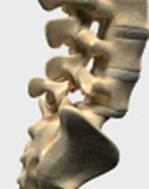During degeneration of the lumbar spine, a slip of the spine may occur – spondylolisthesis. The connections between facet joints are via little projections called pars interarticularis – these may develop a crack in them, often during teenage years and with few symptoms at the time. Some of us are born with cracks in them. However, as the cracks widen, the effect is to allow one bone to slide forwards on the one below. It is this slip which causes a spondylolisthesis and the crack a ‘pars defect’. A spondylolisthesis can also come about due to wear and tear in the facet joints, which then become insecure, allowing the vertebral bones to slip.

Spondylolisthesis, due to a pars defect, may not become symptomatic until degenerative changes occur which lead to increasing instability or narrowing of the central canal and the exit foramen. The disc above the spondylolisthesis may become unstable due to a wobbly vertebra below proving an unstable platform which will add stress going through the disc above. Spondylolisthesis may therefore cause symptoms in a number of ways: the level concerned may cause back pain, the instability may lead to pain in the disc above, the slip of the spine may narrow the spinal canal and compress the nerves to the legs (rarely to those of the bladder and bowel). Therefore, patients suffering from a long-term spondylolisthesis may well be recommended lumbar fusion surgery, especially if conservative treatment has failed.
Some of you may develop a more unusual manifestation of wear and tear arthritis of the spine; a synovial cyst. These are bean sized, fluid-filled or semi-solid bags of tissue that develop in the degenerate ligaments and on the facet joints of the spine. They are notoriously painful and can cause all the same symptoms as a slipped disc. Synovial cysts usually derive from the lining of the facet joint just behind the nerve root and press against the nerve root from behind to cause the same symptoms a disc prolapse does when it presses from the front. Usually, they are a similar size to a prolapse. They are tricky to remove as often they are intimately connected to the lining of the spine (dura) and so CSF (cerebrospinal fluid) leaks are relatively common after this surgery. However, they are not cancers and have no nasty connotations/implications. If you are considering having the synovial cyst removed, please go to excision of lesion of lumbar spine.